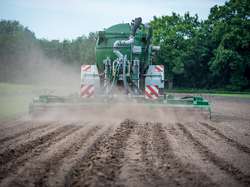Cultivating Kratom: Insights into the Agricultural Practices and Challenges
Hosted by Dwayne Johnson
Tweet Share
Cultivating Kratom: Insights into the Agricultural Practices and Challenges
Kratom (Mitragyna speciosa), a tropical tree native to Southeast Asia, has gained popularity worldwide for its various properties. However, its cultivation presents unique challenges and requires specific environmental conditions. This article provides insights into the agricultural practices associated with kratom cultivation and the challenges faced by growers.
Ideal Growing Conditions
Climate and Soil
Kratom thrives in a tropical climate with high humidity and well-drained soil rich in organic matter. The ideal temperature range for kratom is between 70°F and 90°F (21°C and 32°C). The plant prefers slightly acidic to neutral soil with a pH range of 5.5 to 6.5.
Rainfall and Irrigation
Consistent, heavy rainfall is crucial for kratom, which is why it flourishes in the rainforests of Southeast Asia. In regions with less rainfall, adequate irrigation systems are necessary to mimic these natural conditions.
Cultivation Techniques
Propagation
Kratom is typically propagated from seeds or cuttings. Seeds must be fresh to ensure a higher germination rate, and cuttings require a humid, warm environment to root successfully.
Plantation and Spacing
When establishing a kratom plantation, spacing is crucial for optimal growth. Plants should be spaced sufficiently apart to allow for adequate sunlight and air circulation, which helps prevent diseases.
Pruning and Maintenance
Regular pruning is necessary to encourage bushier growth and more leaf production. Farmers also need to manage weeds and protect plants from pests and diseases, which can be challenging due to the limited availability of kratom-specific agricultural knowledge and resources.
Harvesting and Post-Harvest
Harvesting Techniques
Kratom leaves are usually hand-picked, with a focus on selecting mature leaves that have a higher concentration of alkaloids. The timing of the harvest is crucial and varies depending on the desired effects of the leaves.
Drying and Processing
After harvesting, the leaves are dried, a process that can significantly affect the alkaloid content. Drying methods vary, but typically involve spreading the leaves out in thin layers under the sun or shade.
Challenges in Kratom Cultivation
Environmental Sensitivity
Kratom is sensitive to changes in the environment, making it challenging to grow outside its native habitat. Climate change, with its unpredictable weather patterns, poses a significant threat to kratom cultivation.
Legal and Regulatory Issues
The legal status of kratom varies around the world, which can impact cultivation and export. In some countries, regulatory uncertainty hinders the development of standardized cultivation practices.
Sustainability Concerns
With the increasing demand for kratom, there are concerns about the sustainability of cultivation practices. Overharvesting and deforestation can lead to environmental degradation and loss of biodiversity.
Lack of Standardized Practices
There is a lack of standardized cultivation and processing practices, leading to variability in quality and potency of kratom products.
Conclusion
Cultivating kratom is a complex process that requires specific environmental conditions and careful management. While it presents several challenges, ranging from climate sensitivity to legal issues, understanding these intricacies is crucial for sustainable and effective cultivation. As interest in kratom continues to grow, it becomes increasingly important to focus on developing standardized, sustainable cultivation practices that ensure the plant's longevity and consistent quality.
Comments
Attendees (1)
Dwayne Johnson Yes
HostPhotos
Cultivating Kratom
